Global Tobacco Packaging Market Size and Trends
Global tobacco packaging market is estimated to be valued at USD 20.33 Bn in 2025 and is expected to reach USD 28.63 Bn by 2032, exhibiting a compound annual growth rate (CAGR) of 5% from 2025 to 2032.
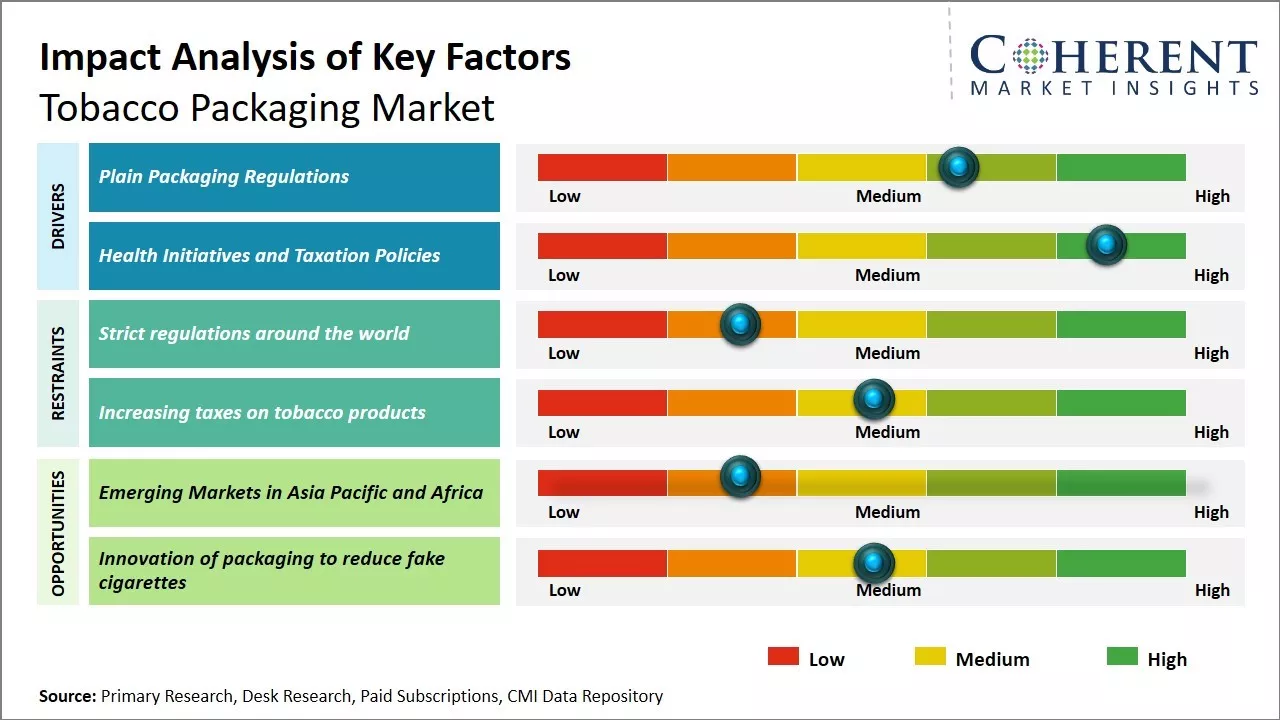
Discover market dynamics shaping the industry: Download Free Sample
Strict government regulations on tobacco products requires manufacturers to incorporate additional health warnings and messages into their packaging. This has boosted demand for updated design and production technologies in the packaging for these regulated products. Global tobacco packaging market is witnessing increased demand for simplified label requirements to satisfy various markets globally. Manufacturers are focusing on innovative packaging designs that attract consumers while also adhering to regulations. Sustainable packaging materials are gaining popularity in the industry as companies aim to reduce environmental impact. Personalization is another emerging trend in tobacco packaging to build stronger brand loyalty and identification.
Plain Packaging Regulations
Governments across various nations have introduced regulations mandating plain or standardized packaging of tobacco products, in order to curb smoking rates. Plain packaging refers to removing all branding elements from cigarette packs including logos, colors and graphics, and replacing them with graphic health warnings. Studies have shown that plain packaging diminishes the appeal of tobacco products, especially among youth and prevents new users from being attracted to specific brands. Several countries like Australia, U.K., France, Norway and Ireland have already implemented plain packaging laws while others are in process of enacting such legislations. Recently, New Zealand also passed plain packaging bill which will come into effect by 2023. This driver is significant as the tobacco packaging market is hugely dependent on brand visibility and differentiation. Plain packaging regulations reduce the role of packaging as a marketing tool for tobacco companies by removing brand imagery and trademarks from packs. Firms have to resort to minimal branding formats approved by governments which impacts their branding strategies. Players have to allocate more resources towards other marketing channels while product differentiation becomes tough. There is also a risk of increase in illicit trade of tobacco products as plain packs are easier to counterfeit.
Market Concentration and Competitive Landscape
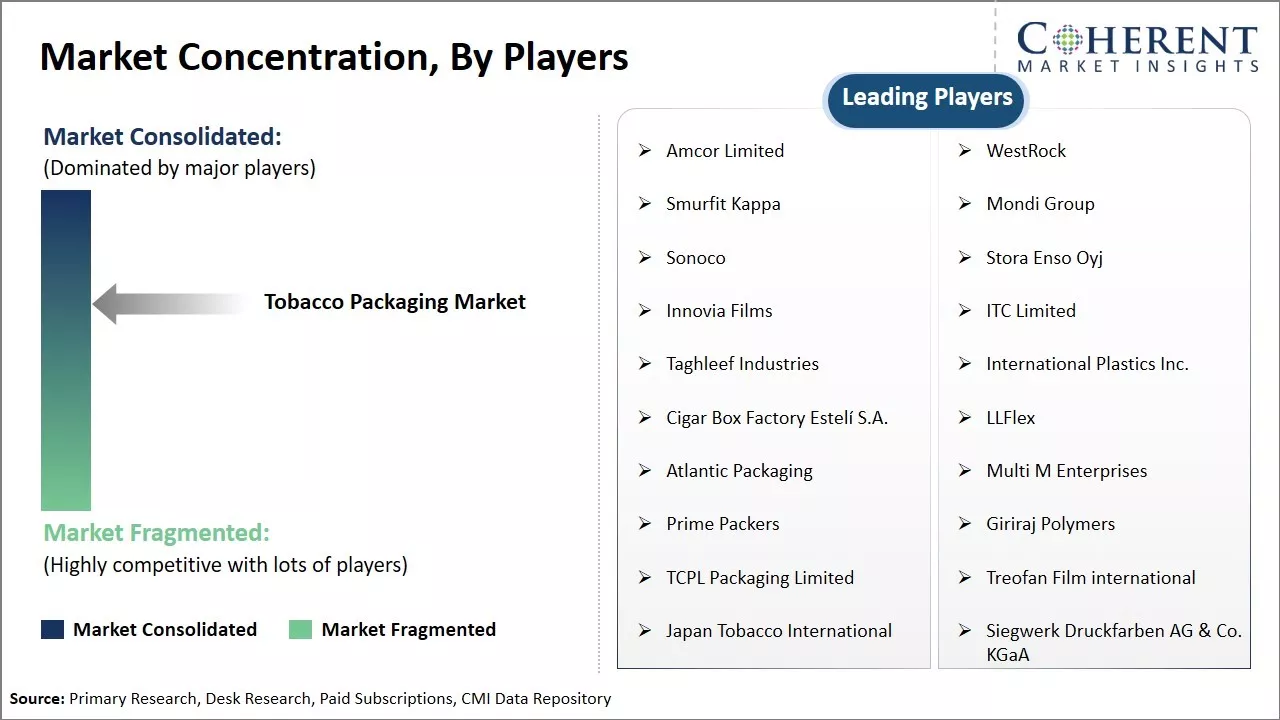
Get actionable strategies to beat competition: Download Free Sample
Health Initiatives and Taxation PoliciesVarious health organizations and anti-tobacco groups across the world are actively promoting campaigns to raise awareness about harmful effects of smoking. These emphasize on graphic health warnings, restrictions on in-store displays and marketing of tobacco products. Governments levy higher taxes on cigarettes as a strategy to discourage tobacco consumption. High taxes not only boost government revenues but also make tobacco products costlier which affects the spending power of smokers. Many developing nations in Asia Pacific and Middle East have particularly raised taxes on cigarettes substantially in past few years based on recommendations of WHO. These health initiatives and fiscal policies indirectly impact the packaging sector. As smoking rates decline with heavy taxation and warning labels, the total demand for tobacco packaging also reduces. Companies experience a fall in volumes affecting their profitability. There is lower spend on inventories, design innovation and new product development. Manufacturers focus on cost optimization to offset losses from tax burdens and changing consumer behavior. The regulatory environment becomes more complex with regional variations in compliances.
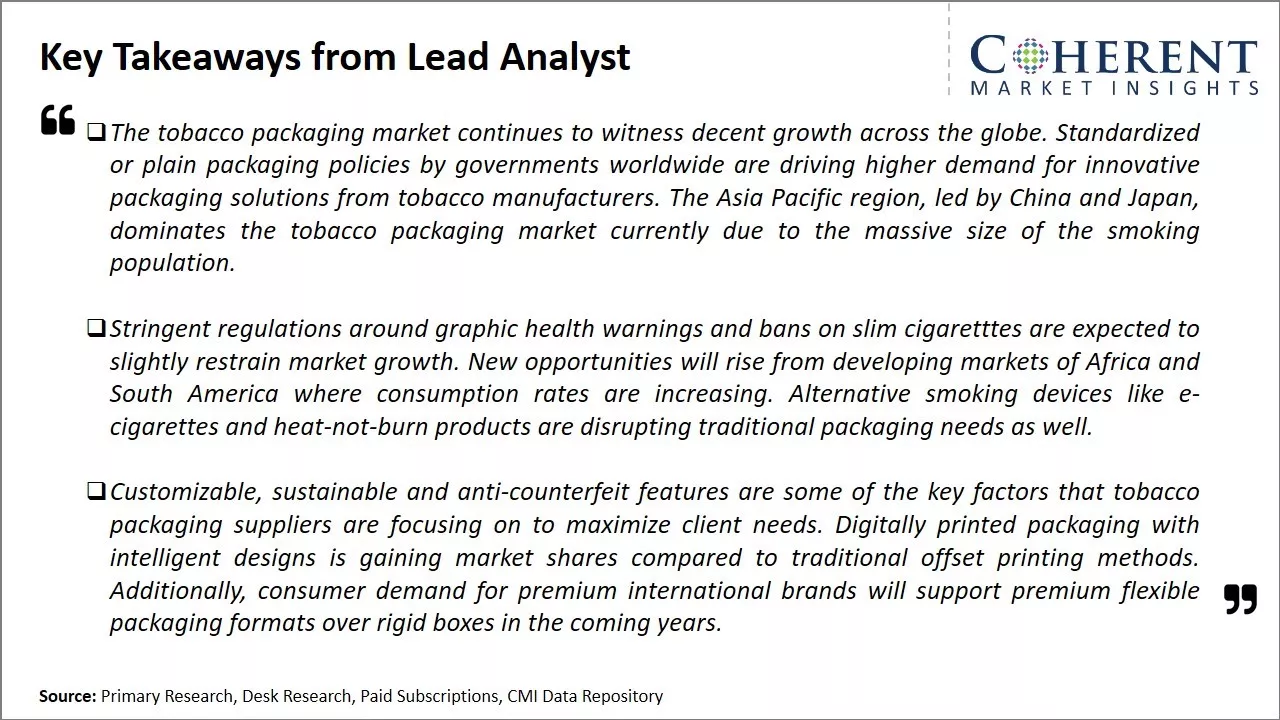
To learn more about this report, Download Free Sample
Market Challenges: Strict regulations around the worldTobacco packaging market faces several challenges due to changing regulations around the world. Governments are increasingly adopting plain or generic packaging laws to reduce the appeal of smoking, especially among young adults. Graphic health warnings are also being expanded to cover more surface area of packs. These regulatory changes aim to decrease tobacco consumption rates. Complying with diverse packaging laws across countries increases costs for tobacco companies. Adult smoking rates are declining in many developed markets. This trend potentially impacts overall packaging demand.
Market Opportunities: Emerging Markets in Asia Pacific and Africa
There are opportunities for packaging manufacturers to introduce packaging formats and materials that meet new regulatory standards. Emerging markets like Asia and Africa still have rising adult consumption, offering opportunities for tobacco and packaging companies to expand their operations and market share. Innovation in packaging design can also help tobacco manufacturers differentiate their brands within a restricted marketing environment.
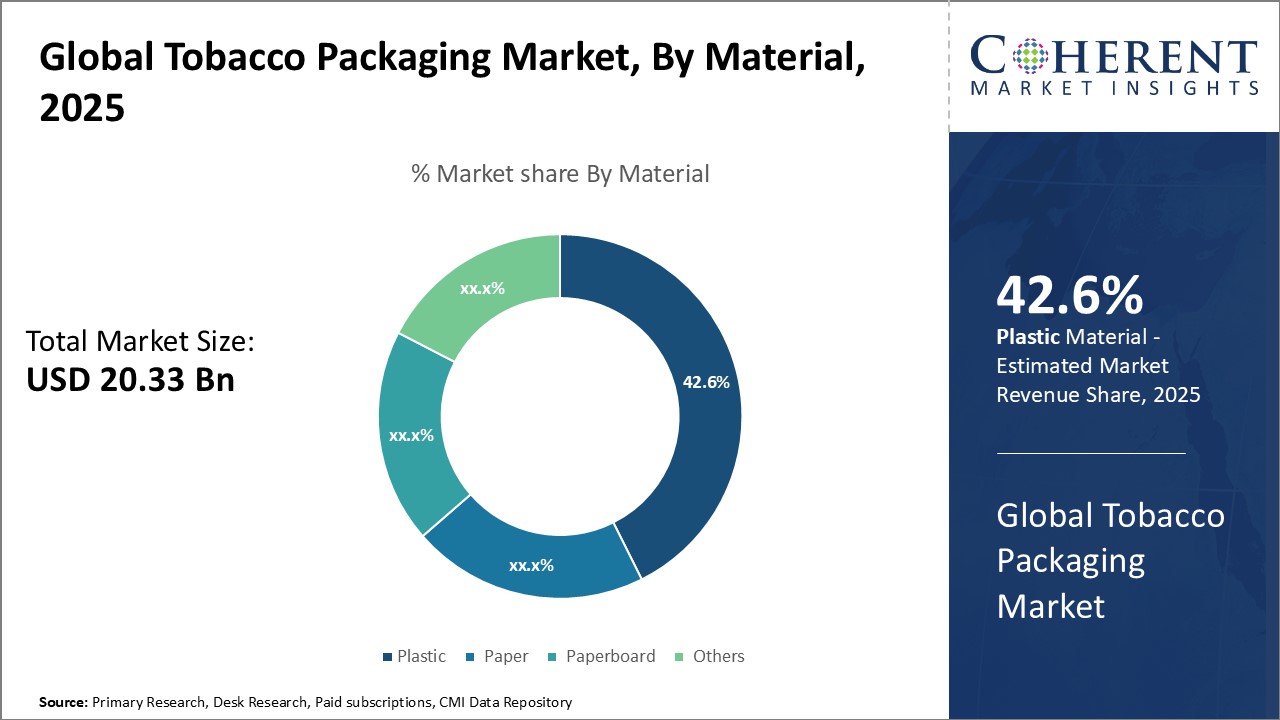
Discover high revenue pocket segments and roadmap to it: Download Free Sample
Insights, By Material: Rising demand from developing nations driving PlasticIn terms of material, plastic segment is estimated to contribute the 42.6% share of the market in 2025, owing to its growing demand from emerging economies. Plastic packaging is increasingly popular among tobacco companies targeting developing Asian and African markets where disposable incomes are rising rapidly. The key advantage of plastic is its low cost compared to paper and paperboard options. This allows tobacco brands to offer affordable packaging solutions without compromising on quality or graphics capabilities. Plastic packaging can also incorporate advanced printing technologies like digital printing more easily compared to paper. This enhances pack designs and branding aspects, appealing to younger consumer segments in developing countries.
Insights, By Product Type: Tradition and regulations favor Folding Cartons
In terms of product type, folding cartons segment is estimated to contribute the 40.3% share of the market due to traditional preferences and regulatory norms. Folding carton packs are seen as premium and retain the old world cigarette charm appealing to older consumers worldwide. These maintain the age old rituals of storing cigarettes in a box and removing them one by one as needed. Furthermore, regulations in developed Western markets often mandate rigid cigarette box designs for health warnings and tax stamps. Folding cartons accommodate such governmental requirements more conveniently compared to flexible films or pouches. Certain Asian countries with robust cigarette cultures also uphold tradition through carton usage. Popular Japanese and Korean tobacco brands prominently feature folding carton boxes accompanying established rituals of cigarette enjoyment. Even as elsewhere pouches and other formats gain, established cigarette markets in North Asia and parts of Europe continue favoring cartons. These create iconic brand images through sophisticated designs possible within rigid paperboard formats. Meanwhile, emerging wellness trends prompt inclusion of carbon filters and additional packaging layers for certain ‘organic’ or ‘light’ cigarette variants marketed to health conscious consumers. Folding cartons integrate such features more constructively. Overall regulations, tradition and opportunities for premiumization sustain carton demand globally.
Insights, By Packaging Type: Secondary packaging boosting visibility, availability
In terms of packaging type, secondary packaging segment is estimated to contribute the 61.7% share due to the vital functions it provides beyond primary packs. Secondary packaging refers to the cartons, bundles or shipping cases holding cigarette packs during storage and distribution till point of sale. It is critical for brand visibility and availability across diverse selling environments from kiosks to supermarkets. Sophisticated secondary packs prominently display brand logos, messaging and graphics eye-catchingly at retail shelves. This boosts top-of-mind awareness and trial among consumers making quick purchase decisions. Secondary packs also facilitate streamlined logistics and space optimization within modern multi-product retail setups. Their standardized structures enable convenient stacking, loading and stocking across complex multi-temperature warehouse and inventory systems. It supports just-in-time production and delivery vital for coordinated supply chains. Secondary packs further aid merchandising through unified displays of SKU varieties enhancing availability perceptions. Their structure allows consolidated handling, tracking and inventory management till the storefront. Overall secondary packaging plays a crucial role in visual communications, operational effectiveness and final availability driving per unit sales volumes globally.
Regional Insights
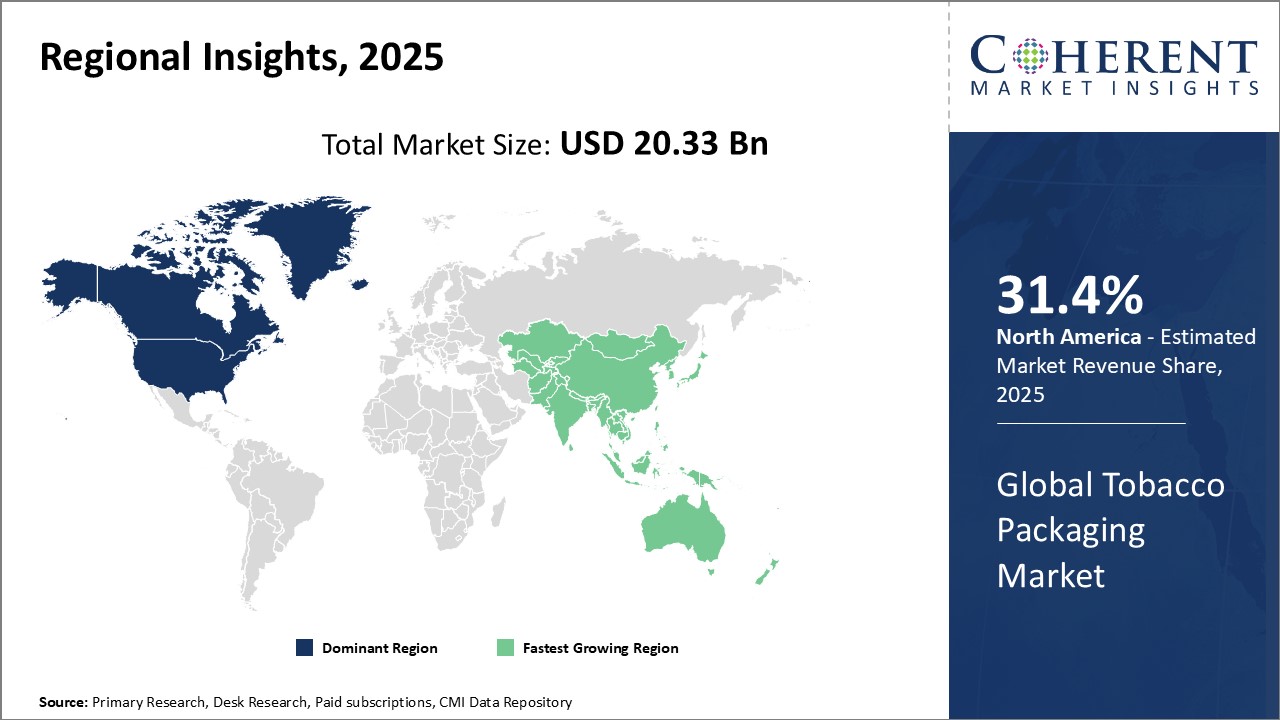
Need a Different Region or Segment? Download Free Sample
North America has long dominated the global tobacco packaging market with estimated 31.4% share in 2025 due to the presence of major tobacco companies in the U.S. and Canada. The U.S. market alone accounts for over a third of the total packaging demand, led by the nation's large consumer base and established tobacco industry. Packaging manufacturers have gained from the stringent regulations regarding health warnings and packaging types that require constant changes in design for cigarette sticks and cartons. This ensures repeat business from tobacco firms trying to comply with rules while maintaining brand appeal.
The Asia Pacific region has emerged as the fastest growing market for tobacco packaging in recent years. Rising disposable incomes and exposure to global marketing campaigns have lifted tobacco consumption steadily across developing nations. China is a major contributor as both a consumer and manufacturer due to its huge population and ability to produce packaging materials at competitive prices for exports. Neighboring countries have also shown high growth rates fueled by regional trade flows and preferences for international brands. With increasing health awareness, further opportunities could arise from innovative packaging solutions that aim to curb underage use or indicate health risks.
Market Report Scope
Global Tobacco Packaging Market Report Coverage
| Report Coverage | Details | ||
|---|---|---|---|
| Base Year: | 2024 | Market Size in 2025: | USD 20.33 Bn |
| Historical Data for: | 2020 To 2024 | Forecast Period: | 2025 To 2032 |
| Forecast Period 2025 to 2032 CAGR: | 5.0% | 2032 Value Projection: | USD 28.63 Bn |
| Geographies covered: |
|
||
| Segments covered: |
|
||
| Companies covered: |
Amcor Limited , WestRock , Smurfit Kappa , Mondi Group , Sonoco , Stora Enso Oyj , Innovia Films , ITC Limited , Taghleef Industries , International Plastics Inc. , Cigar Box Factory Estelí S.A. , LLFlex , Atlantic Packaging , Multi M Enterprises, Prime Packers, Giriraj Polymers, TCPL Packaging Limited, Treofan Film international , Japan Tobacco International , Siegwerk Druckfarben AG & Co. KGaA |
||
| Growth Drivers: |
|
||
| Restraints & Challenges: |
|
||
Uncover macros and micros vetted on 75+ parameters: Get instant access to report
Market Segmentation
- Material Insights (Revenue, USD Bn & KT, 2020 - 2032)
- Plastic
- Paper
- Paperboard
- Others
- Product Type Insights (Revenue, USD Bn & KT, 2020 - 2032)
- Boxes
- Folding Cartons
- Films & Wraps
- Bags & Pouches
- Others
- Packaging Type Insights (Revenue, USD Bn & KT, 2020 - 2032)
- Primary
- Secondary
- Regional Insights (Revenue, USD Bn & KT, 2020 - 2032)
- North America
- U.S.
- Canada
- Latin America
- Brazil
- Argentina
- Mexico
- Rest of Latin America
- Europe
- Germany
- U.K.
- Spain
- France
- Italy
- Russia
- Rest of Europe
- Asia Pacific
- China
- India
- Japan
- Australia
- South Korea
- ASEAN
- Rest of Asia Pacific
- Middle East & Africa
- GCC Countries
- Israel
- Rest of Middle East & Africa
- North America
- Key Players Insights
- Amcor Limited
- WestRock
- Smurfit Kappa
- Mondi Group
- Sonoco
- Stora Enso Oyj
- Innovia Films
- ITC Limited
- Taghleef Industries
- International Plastics Inc.
- Cigar Box Factory Estelí S.A.
- LLFlex
- Atlantic Packaging
- Multi M Enterprises
- Prime Packers
- Giriraj Polymers
- TCPL Packaging Limited
- Treofan Film international
- Japan Tobacco International
- Siegwerk Druckfarben AG & Co. KGaA
Share
Share
About Author
Pankaj Poddar is a seasoned market research consultant with over 12 years of extensive experience in the fast-moving consumer goods (FMCG) and plastics material industries. He holds a Master’s degree in Business Administration with specialization in Marketing from Nirma University, one of India’s reputed institutions, which has equipped him with a solid foundation in strategic marketing and consumer behavior.
As a Senior Consultant at CMI for the past three years, he has been instrumental in harnessing his comprehensive understanding of market dynamics to provide our clients with actionable insights and strategic guidance. Throughout his career, He has developed a robust expertise in several key areas, including market estimation, competitive analysis, and the identification of emerging industry trends. His approach is grounded in a commitment to understanding client needs thoroughly and fostering collaborative relationships. His dedication to excellence and innovation solidifies his role as a trusted advisor in the ever-evolving landscape of not only FMCG but also chemicals and materials markets.
Missing comfort of reading report in your local language? Find your preferred language :
Transform your Strategy with Exclusive Trending Reports :
Frequently Asked Questions
EXISTING CLIENTELE
Joining thousands of companies around the world committed to making the Excellent Business Solutions.
View All Our Clients
